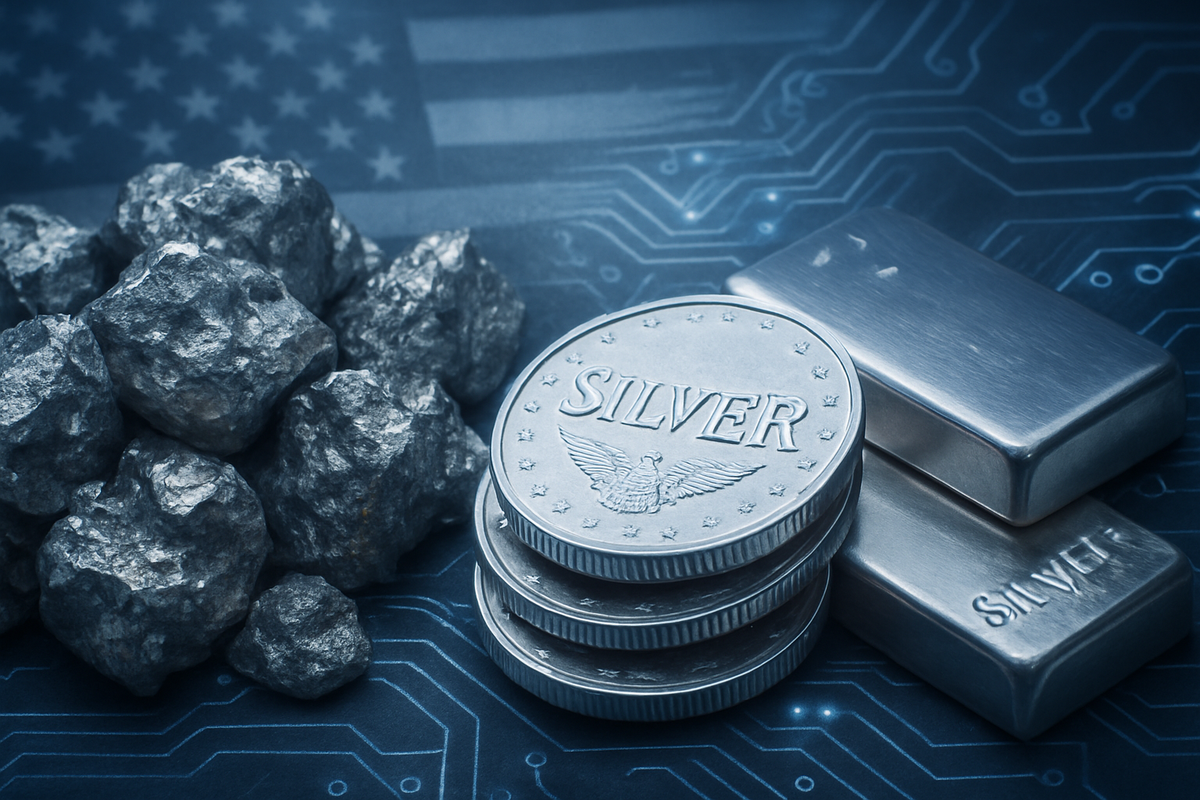Financial News
Silver's New Dawn: U.S. Designates Precious Metal as Critical Mineral, Reshaping Market Dynamics

In a landmark decision poised to send ripple effects across global financial markets and industrial sectors, the U.S. government has officially designated silver as a critical mineral. This strategic reclassification, finalized around November 2025 by the U.S. Geological Survey (USGS) and announced by the Department of the Interior, marks a pivotal shift in how the versatile metal is perceived, elevating it from a mere precious commodity to a strategic industrial asset vital for national security and economic prosperity.
The move underscores silver's indispensable role in a rapidly evolving technological landscape, from renewable energy to advanced electronics and defense applications. This designation is expected to usher in a new era for silver, potentially influencing everything from federal policy and investment to mining operations, supply chain security, and, critically, its market price and demand.
A Strategic Shift: Unpacking Silver's Critical Mineral Status
The journey to silver's critical mineral designation commenced with a draft list published in the Federal Register on August 26, 2025, which included silver among several new additions. The official announcement followed swiftly in November 2025, aligning with the USGS's triennial update to its critical minerals list – an assessment considered the most comprehensive since the list's inception in 2017. This swift progression highlights the urgency and strategic importance the U.S. government places on securing vital mineral resources.
Key players involved in this decision include the U.S. Geological Survey (USGS), responsible for identifying and assessing critical minerals, and the Department of the Interior, which formalizes these designations. The broader context involves the U.S. government's overarching strategy to bolster domestic supply chains and reduce reliance on foreign imports for materials deemed essential for national security and economic stability. Given that the U.S. imports approximately two-thirds of its silver supply, this designation is a direct response to vulnerabilities in the supply chain.
Initial market reactions have been notable, with fears of future tariffs under Section 232 of the Trade Expansion Act reportedly leading to a rush to move silver into New York warehouses earlier in the year. This influx impacted market liquidity and contributed to record-high silver prices in early October, demonstrating the immediate sensitivity of the market to regulatory signals. The designation is anticipated to trigger increased demand through potential government stockpiling initiatives and heightened industrial recognition, particularly in burgeoning sectors like solar energy, electric vehicles, and advanced electronics, where silver's conductive and reflective properties are irreplaceable.
Winners and Losers: Corporate Implications of the Designation
The U.S. government's designation of silver as a critical mineral is set to redraw the competitive landscape for numerous public companies, creating distinct winners and losers across the mining, manufacturing, and technology sectors. For silver mining companies operating within the United States or those with significant U.S. interests, this designation could be a substantial boon. These companies may now be eligible for federal funding, streamlined permitting processes, and other supportive measures aimed at boosting domestic production. This could reduce operational costs, accelerate project development, and enhance profitability.
Conversely, companies heavily reliant on imported silver, particularly those in manufacturing sectors without diversified supply chains, might face increased costs or supply volatility. The potential for tariffs under Section 232 of the Trade Expansion Act, though not yet implemented, looms as a significant risk. This could force companies to re-evaluate their sourcing strategies, potentially leading to higher input costs for products ranging from solar panels to electronic components. Companies that can adapt quickly by securing domestic supply agreements or investing in recycling technologies could mitigate these risks.
Furthermore, the designation could spur innovation in silver extraction and processing technologies. Companies developing more efficient or environmentally friendly mining techniques could see increased demand for their services and technologies. For example, firms specializing in precious metals recycling might also benefit significantly, as the drive for domestic supply security could lead to greater investment in urban mining initiatives to recover silver from electronic waste. This could create new revenue streams and opportunities for specialized recyclers.
The broader industrial applications of silver mean that companies in the solar energy sector (e.g., First Solar (NASDAQ: FSLR)), electric vehicle manufacturers (e.g., Tesla (NASDAQ: TSLA), General Motors (NYSE: GM)), and electronics giants (e.g., Apple (NASDAQ: AAPL), Intel (NASDAQ: INTC)) will be closely watching the supply dynamics and price movements. While the designation aims to secure supply, any initial disruption or price surge could impact their manufacturing costs. These companies may need to explore long-term supply contracts or invest in R&D to find alternative materials where feasible, though silver's unique properties make it difficult to substitute in many critical applications.
Wider Significance: A New Era for Industrial Metals
The designation of silver as a critical mineral transcends its immediate market implications, fitting into a broader global trend of nations striving to secure essential raw materials amid increasing geopolitical tensions and supply chain vulnerabilities. This move by the U.S. government signals a strategic pivot towards resource nationalism, mirroring similar actions taken by other major economies to safeguard access to minerals vital for their technological advancement, defense capabilities, and economic resilience. It underscores a growing recognition that "green technologies" and advanced manufacturing are heavily reliant on a finite and sometimes geopolitically sensitive supply of specific metals.
This event is likely to have significant ripple effects on competitors and partners globally. For major silver-producing nations like Mexico, Peru, and China, the U.S. designation could influence their export strategies and pricing power. Nations that are major importers of silver, such as India, may face increased import costs and tighter global supplies as the U.S. prioritizes domestic sourcing and potentially stockpiling. This could lead to a fragmentation of the global silver market, with different pricing and supply dynamics emerging in various regions.
From a regulatory and policy perspective, the designation will guide federal strategy, investment, and mine permitting decisions within the U.S. This could translate into more favorable regulatory environments for domestic silver mining projects, potentially streamlining environmental reviews and accelerating approvals. It also opens the door for federal funding and research grants aimed at improving extraction efficiency, developing new processing technologies, and exploring alternative domestic sources. Historically, similar designations for other minerals have led to significant government intervention and investment, such as the strategic petroleum reserve or various initiatives to secure rare earth elements. These precedents suggest a long-term commitment to enhancing silver supply security.
The move also highlights the evolving definition of "criticality." While traditionally focused on minerals essential for defense and high-tech, the emphasis has broadened to include materials vital for the energy transition and economic competitiveness. Silver's expanding role in solar photovoltaic cells, electric vehicle components, and advanced medical devices firmly places it at the intersection of these priorities. This wider significance means that the designation is not just about silver; it's about a fundamental re-evaluation of resource security in the 21st century.
What Comes Next: Navigating the Evolving Silver Landscape
The U.S. government's designation of silver as a critical mineral sets the stage for a dynamic period of adjustment and opportunity across the market. In the short term, investors and industries should brace for increased market volatility as participants fully digest the implications. Speculative trading might intensify, driven by anticipation of government stockpiling initiatives and potential tariff actions. We could see a short-term surge in prices as industrial buyers and strategic reserves seek to secure supply, especially given the inherent inelasticity of silver production. Mining companies with existing U.S. operations or advanced exploration projects are likely to see increased investor interest and potential for accelerated development.
Looking further ahead, the long-term possibilities are profound. The designation is expected to drive sustained investment in domestic silver exploration and mining, potentially leading to an expansion of U.S. production capacity over several years. This could involve new mine openings, the reopening of dormant sites, and technological advancements to extract silver more efficiently from lower-grade ores or as a byproduct of other mining operations (e.g., copper, lead, zinc). Furthermore, the emphasis on supply chain security could spur significant innovation in silver recycling technologies, reducing reliance on virgin material and creating a more circular economy for the metal.
Market opportunities will emerge for companies specializing in mining equipment, environmental consulting for permitting processes, and advanced materials science focused on optimizing silver use or finding new applications. Challenges will include navigating the complex regulatory landscape, managing environmental impacts of increased mining, and ensuring a skilled workforce is available for an expanding domestic industry. For international markets, the U.S. move could prompt other nations to reassess their own critical mineral lists and supply chain vulnerabilities, potentially leading to a global scramble for strategic resources.
Potential scenarios range from a steady, managed increase in domestic silver supply supported by federal incentives, to a more aggressive, protectionist approach involving tariffs and strict import controls. The outcome will largely depend on geopolitical developments, the pace of technological adoption requiring silver, and the U.S. government's ongoing commitment to resource independence. Strategic pivots for industries will involve diversifying supply chains, investing in R&D for material substitution where possible, and engaging with policymakers to shape favorable trade and mining policies.
A New Chapter for Silver: Lasting Impact and Investor Watch Points
The U.S. government's designation of silver as a critical mineral marks a significant inflection point, fundamentally altering its status from primarily a precious metal to a strategic industrial asset. The key takeaway is a reinforced commitment to securing domestic supply chains for materials vital to national security and economic growth, particularly in the context of the burgeoning green energy and high-tech sectors. This decision underscores silver's irreplaceable role in solar panels, electric vehicles, and advanced electronics, ensuring its long-term demand profile is robust and strategically important.
Moving forward, the market will likely experience a period of heightened activity and potential re-pricing of silver. The assessment is that this designation will provide a strong tailwind for domestic silver production and related industries, while potentially increasing costs or complexities for international suppliers and those heavily reliant on imports. The lasting impact will be a more secure, albeit potentially more expensive, supply of silver for U.S. industries, fostering innovation in extraction and recycling, and reinforcing the metal's critical role in the 21st-century economy.
Investors should closely watch several key indicators in the coming months. These include any announcements regarding federal funding or incentives for domestic silver mining projects, progress on streamlined permitting processes, and the development of any Section 232 tariff discussions. Monitoring the inventory levels in major warehouses, global production figures, and demand trends from the solar and EV sectors will also be crucial. Publicly traded silver mining companies (e.g., Coeur Mining (NYSE: CDE), Hecla Mining (NYSE: HL)) with U.S. assets or exploration potential may present opportunities, as could companies involved in silver recycling or advanced materials. The broader geopolitical landscape and trade policies will also play a significant role in shaping silver's trajectory.
This content is intended for informational purposes only and is not financial advice
More News
View More




Recent Quotes
View More
Quotes delayed at least 20 minutes.
By accessing this page, you agree to the Privacy Policy and Terms Of Service.



